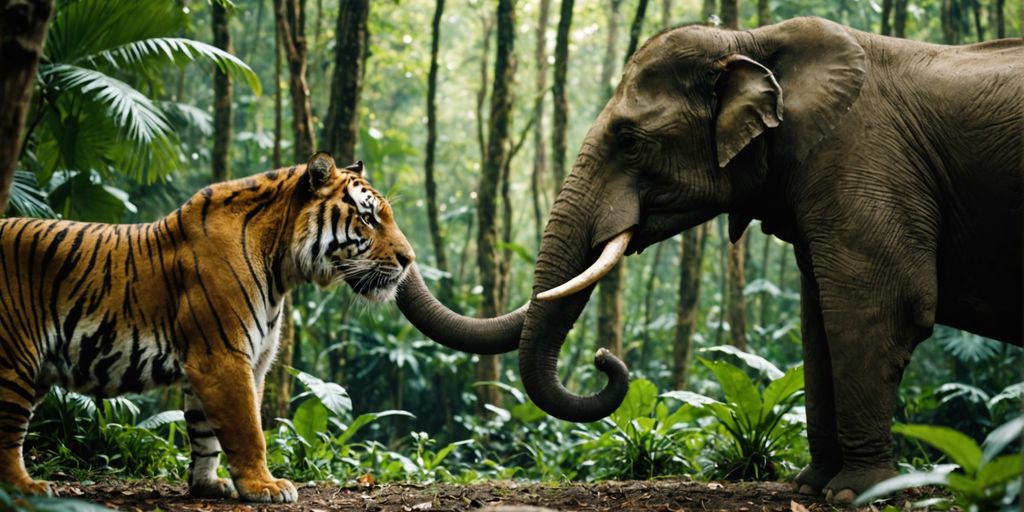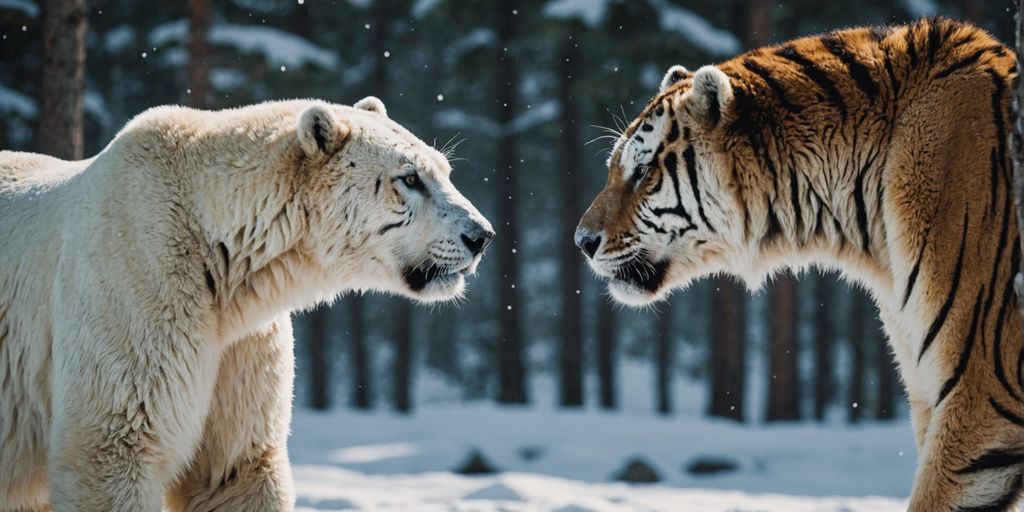Your Cart is Empty
🙏HELP US SAVE TIGERS!🐅 WE DONATE 1% OF OUR SALES TO WILDLIFE ORGANIZATIONS ( WWF ...)
Menu

🙏HELP US SAVE TIGERS!🐅 WE DONATE 1% OF OUR SALES TO WILDLIFE ORGANIZATIONS ( WWF ...)
What is a Siberian Tiger?
May 28, 2021 8 min read

The Siberian Tiger is one of the subspecies of the Tiger living in East Asia. It belongs to the six subspecies of Tigers still alive today, along with the Bengal, Sumatran, South Chinese, Indochinese and Malayan Tigers. The latter is also called Amur Tigers about the Russian region where they are found in quantity.
At first glance, Siberian Tigers do not have any apparent differences with other subspecies of Tigers. However, their thick orange fur, the tuft of hair around their necks, and the almost white coat on their bellies can be differentiated by their thick orange fur.
This subspecies is the largest of all the Tigers, as it must be tough to survive in such extreme conditions. Most of these tigers are about 3 meters long and weigh 250 kg daily. Compared to other subspecies, the Siberian Tiger has a thicker and denser fur and a robust body.
If you want to learn more about tigers, including their weight, make sure to check out How much does a tiger weigh on Tiger Universe.
The IUCN (International Union for Conservation of Nature) considers the Siberian Tiger an endangered animal. However, thanks to strict conservation and protection laws, the giant cat population has stopped decreasing. Despite this, it is still threatened by poaching and deforestation.
Seeing these wild animals in their natural environment must surely be a fantastic sight to behold. They are impressive creatures and mighty predators. It is for all these reasons that Tiger Universe invites you to discover the things that make this beast a Tiger like no other!
The Habitat of the Siberian Tiger

The main habitats of the Siberian tiger are taiga, snowy forests, birch forests, and boreal forests. As said before, it lives and evolves in harsh conditions. Winters are frigid, and snowfall can be hefty during this season. The vast majority of these populations of Tigers live in mountainous regions, far from any human infrastructure. Their choice of habitat also depends on the availability of prey.
Love Tigers live in a harsh climate with frequent snowstorms and freezing temperatures. As a result, their bodies have adapted to this cold climate, which explains their large size. Because a large animal retains heat better than a small one, it is not surprising that Amur Tigers are larger than other subspecies of Tigers, which live in warmer regions.
In addition to their size, Siberian Tigers have other characteristics to beat the cold. They have a layer of fat (on their flanks and belly) that protects them from the Siberian winter. Their coat is also helpful: their thick fur grows longer during the coldest periods. And like most Tigers, Amur Tigers have a ruff of fur around their neck. This tuft of hair is much more developed in them than in any other subspecies. Finally, these big cats have extra skin on their paws to protect them from cold burns.
Like all Tigers, their coat is orange-gold with black stripes. They also have some white spots on their belly, chest, throat, and muzzle. Compared to other Tigers, Siberian Tigers have a whiter coat with fewer stripes.
Have fun solving this Tiger Puzzle in the image of the great Siberian fawn!
The Distribution of the Fauve

Today, the Siberian Tiger lives in a much smaller territory than it used to. Most of these Tigers live in eastern Russia and northern China. A large part of the Amur Tiger population lives in the Sikhote-Alin mountain range.
Some Siberian Tigers live in captivity in zoos and reserves around the world outside their natural range. Historically, their content extended over a large part of Russia, Korea, and the entire northern part of China. Nowadays, they are primarily found in eastern Russia, in the heart of the Amur region.
An unlikely camouflage

Although it may not look like it, the Tiger's stripes are a very effective camouflage. When you look at a tiger on a white background, it is impossible not to see it. However, the colors and patterns of the Siberian forests are far from snow white! In the tall grass or woods, the Tiger's stripes blend perfectly with the environment around them.
The Tiger is a versatile animal that perfectly knows how to become one with its environment. In addition to its stripes, its silent approach contributes significantly to its camouflage in snowy forests. It is also important not to confuse the Siberian Tiger with the White Tiger; these 2 Tigers have absolutely nothing in common.
The inhospitable habitat of the Siberian Tiger is its highest advantage. This is because the climate is so extreme that very few populations cohabit with this species. This way, there are many more forests untouched by humans and thus more prey for the Tigers to catch.
The Cat's diet

Like its cousins, the Siberian Tiger is a large carnivore that feeds solely on meat. The Amur Tigers' large size gives them an advantage when hunting their favorite prey: large animals like wild boar, elk, and deer. Tigers use a lot of energy hunting, so they prefer to hunt large prey to feed them over several days. Despite this, they still nibble on various small creatures, such as birds, fish, and mice.
In pursuit of food, tigers fly long distances, hunting at all hours of the day, although they prefer to attack at night. They are not great runners, and they rarely hunt their prey over long distances. They approach their target stealthily, hiding behind trees, rocks, or bushes. Siberian Tigers get as close as possible before pouncing with all their might on their victim.
When it comes to killing their prey, Tigers use one of two methods. If it's a small animal, they kill it by attacking it at the neck; it takes them less than 10 seconds to break the neck. If it is a large animal, they kill it by choking it with a bite to the throat. A large herbivore killed can provide food for several days for a lone Tiger.
The behavior of this Snow Felid

Siberian Tigers are solitary creatures, which do not tolerate living in a community. Except for Tigresses and their cubs, they live alone and rarely contact other cats. One male occupies a large territory that overlaps the ranges of several females. Although they spend most of their time alone, the Tigers are not anti-social. They maintain contact with females by a variety of methods.
Scent marking is perhaps the most important means of communication for Tigers. Both males and females spray a "marking fluid" (often mixed with urine) on rocks and trees. This scent trail provides essential information about the animal that left them: individual identity, sex, breeding status, and the time the mark was made.
Tigers also communicate by leaving visual clues. These include scratches (marks made by raking the ground with their hind legs), claw marks, and scat. Another way for them to recognize each other is through physical appearance itself. Since each Tiger has a unique stripe pattern, individuals likely identify themselves through this.
In addition to visual cues and scent, Siberian Tigers also communicate by making sounds. They have a wide range of vocalizations, including a roar, growl, snarl, whine, hiss, and even a meow. Depending on the situation, the Tiger will use a different vocalization, such as the roar emitted by females when they are ready to mate. So even though Tigers are loners, they still keep in touch!
The Tiger of Love and interactions with humans

Of all the subspecies, the Siberian Tiger interacts the least with humans. Their inhospitable habitat is their best friend in this regard, as humans rarely share the same space as these striped beasts. The vast majority of Tiger attacks occur because a poacher attempts to confront and kill the big cat. In some cases, injured or starving Tigers attack humans, but this is quite rare.
Unfortunately, humans tend to come looking for trouble. Siberian Tiger populations remain threatened by poaching and habitat destruction. Most poachers kill Tigers for their fur and sell their body parts on the black market. Some ranchers also kill them to prevent these Tigers from feeding on their livestock.
What is certain is that man has never managed to domesticate the tiger in any way fully. Siberian Tigers cannot be suitable pets because their predatory instinct never leaves them. More generally, no tiger is meant to be a pet, unlike in cities like Dubai, where some rich families own Tigers, Lions, Panthers, and other felines as pets.
Care of these Animals

Zoos have many regulations that differ by the country for the care of their Tigers. Siberian Tigers must live in secure enclosures with fences high enough to prevent them from escaping. Zookeepers feed them ground meat produced and explicitly intended for the carnivores in the zoo.
They also provide the Tigers with toys, water sources for swimming and train them physically and morally not to slack off. Zookeepers regularly take blood samples from the Tigers to ensure their good health. If the training has been well done, the Tigers will naturally let themselves be bitten without resistance.
How do they reproduce?

Siberian Tigers begin breeding at about four years of age. Females use scent marking at the edge of their territory to broadcast their readiness to mate. Males stay with the female for the duration of the breeding, which lasts one week. After that, the male leaves and lets the tigress raise her cubs alone.
The males do not participate in any way in raising the cubs. The female's gestation period is about three months, and she usually gives birth to 3 cubs. Tiger cubs begin hunting when they are one and a half years old, however, when they are two or three years old, they are raised by their mother. When they reach this age, they abandon their family and embark on a life of solitude and complete freedom.
Siberian Tigers are an endangered species.

There used to be nine subspecies of Tigers; today, 3 of them, including the Java Tiger, are extinct. Three other subspecies are critically endangered; the Siberian Tiger is one. It's estimated between 350 and 450 Amur Tigers are still in the wild. In addition to being very small in number, their range has been drastically reduced over time. In the past, they lived in large part of Siberia and the surrounding regions, so they are still called Siberian Tigers.
Today, they are hardly found in Siberia, but they have kept their old name. The biggest threat to these Tigers is the loss of their habitat due to logging. Prey is fleeing the Amur region, causing them to sometimes turn to domestic livestock for food. This makes them unpopular with ranchers, who do not hesitate to shoot them.
Tigers are killed for a variety of purposes, including the use of their meat, skin, and bones in traditional Chinese medicine. The poaching of Tigers has become a growing problem in recent years, and it takes a heavy toll on these powerful cats.
Fortunately, efforts are underway to help the Amur Tigers conserve their natural habitat. Work is being done to create a network of protected areas. In the fight against the poaching problem, efforts are being made to set up police services and anti-poaching teams.
In summary

The Siberian Tiger is a fantastic beast that is quite different from other species of Tigers. Its impressive physique and its ability to survive in such a hostile environment immediately place it in the rank of a superior animal. But even though this big cat is so exceptional, it is in great danger today because of man's actions.
Hunting is a significant threat to Siberian Tigers and all other animal species, for that matter. Poaching is not nearly as widespread as it once was, but it still exists. After poaching, habitat destruction is the most destructive factor for tigers. Sawmills and logging operations destroy the tiger's land and prevent it from finding new prey.
To help conserve the Siberian Tiger, you mustn't purchase products made from Tigers and encourage your friends and family to do the same. Also, when purchasing wood products, make sure that the wood was harvested without destroying the Tigers' habitat. Through little actions like these, the Siberian Tiger will continue to be a dream for big cat lovers!
To see our latest collection of Tiger Masks, it's right here.⤵️
Also in Tiger Blog

Sloth Bear vs Tiger: Who Would Win?
July 13, 2024 7 min read
Explore the thrilling showdown between a sloth bear and a tiger, analyzing their strengths, behaviors, and survival tactics.
Read More
Tiger vs Elephant: Who Reigns Supreme in the Animal Kingdom?
July 13, 2024 7 min read
Explore why elephants usually triumph over tigers in the wild, highlighting their size, strength, and defensive prowess.
Read More
Epic Battle: Polar Bear vs Tiger, who win?
July 11, 2024 8 min read
Epic showdown: Polar Bear vs Tiger. Discover who would win in this thrilling battle of nature's fiercest predators.
Read More
